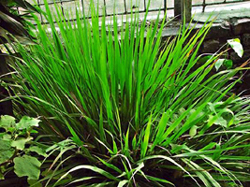Lemon Grass
Lemon Grass a perennial essential oil-yielding grass, Cymbopogon citratus, of the family Gramineae found wild and cultivated in some tropical countries. It is a tufted grass with extensive network of fibrous roots attaining a height up to one metre at vegetative stage and propagated by rooted slips.

The inflorescence is long erect spike about a metre in length. The oil is extracted by steam distillation, has a strong odour and test of lemon. The young leaves contain 0.50-80% oil. The oil is yellowish having 75-85% citrol and small amount of ionones which causes aroma of lemon. The main uses are in perfumery, soaps, cosmetics, insect repellent, deodorant and for synthesis of vitamin-A.
India is the largest producer of lemon grass (about 80%). In Bangladesh the grass grows naturally in northern and eastern hilly regions. Some high yielding varieties have been selected and cultivated in the BCSIR laboratories, Chittagong, but there is no report of commercial extraction of oil though it is cultivated sporadically in some places. Green leaves are extensively used in soups in the Chinese restaurants. The average per acre yield in Bangladesh condition is about 70 kg/year. [Mostafa Kamal Pasha]
